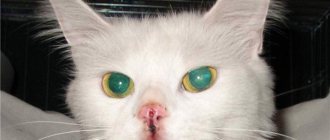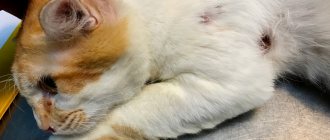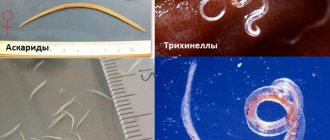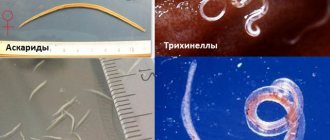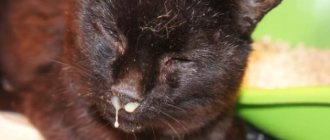Often, pet owners, when they see black plaque in a cat’s ears, do not attach any special significance to this phenomenon. They think that it’s just dirt and dust accumulated in the ear, so they try to remove the plaque with cotton swabs, or do nothing at all to get rid of the problem. The opinion that black plaque does not cause any discomfort or harm to the animal is erroneous. It is worth understanding what the reasons are for its appearance and how to eliminate such plaque.
Causes of plaque and provoking factors for its accumulation
Let's consider the main reasons for the appearance of plaque and provoking factors
- The natural process of earwax accumulation. This is also typical for cats, and therefore even pets need to clean their ear canals and ears from time to time. The intensity of this phenomenon varies from animal to animal: in some cats, plaque is barely noticeable even after six months, while in other pets, after a month, the ears are heavily clogged with it. The ears of animals with large ears (Sphynxes, Siamese cats, etc.) require especially careful care and attention.
- Symptom of otodectosis, i.e. ear mite. In severe cases, plaque is the least of the problems, since the cat develops severe inflammation in the ear canals, allergic reactions are also possible, especially “lucky” cats die from sepsis or meningitis, provoked by otitis media of parasitic (more precisely, tick-borne) origin. In these same cases, a large amount of foul-smelling, brownish-red exudate often flows from the ear canals of a sick animal. It is the ear mite that in most cases is responsible for the formation of a large amount of brown plaque. Therefore, we would recommend that you do not rush to clean your cat’s ears, but immediately show your pet to a veterinarian. The sooner treatment is started, the greater the chance that severe otodectosis can be avoided.
- Various types of otitis (i.e. inflammation of the ears). Otitis is a very typical complication of the same otodectosis. Primary ear inflammation is extremely uncharacteristic for these animals.
- Fungal and yeast ear infections.
- Long hair and large ears , i.e. The ears of the same Sphynx or Persian cats need special care.
Diseases accompanied by the appearance of brown plaque: list and description
In general, we have already described all the diseases accompanied by the appearance of brown plaque, but in this chapter they need to be considered in more detail.
Otodectosis
The most typical cause of plaque is otodectosis. Otodectes Cynotis mites live in the ear canals of cats. They especially love warmth and dampness. They feed on the epithelium of dead skin, as well as blood and lymph.
The plaque these “guests” leave behind is their feces, as well as the corpses of dead individuals, chitin shed during the growth of young individuals, as well as other waste products. In most cases, infection occurs through direct contact of a cat with sick relatives.
The disease is accompanied by the following symptoms:
- Copious brownish deposits in the ears, increasing in volume at a shocking rate.
- The cat's ears itch unbearably. Soon the ears take on a completely pathetic and indecent appearance, being torn almost to shreds.
- Due to the inflammatory reaction in the ear canals, the exudate mentioned above begins to be released from them.
Very often, advanced cases of otodectosis are accompanied by purulent otitis (due to the intervention of pathogenic microflora), as well as allergic reactions, the latter sometimes ending in anaphylactic shock.
Otitis
This is what inflammation of the ear is called. And not only the ear canal, as some breeders think. Otitis can occur in the following forms:
- Outer. Only the auricle and adjacent soft tissues are affected.
- Middle (also called medial). The ear canal is affected.
- Interior. The most severe option, associated with inflammation of the inner ear, eardrum, etc. Can lead to death due to sepsis or brain damage.
The accumulation of plaque is accompanied by the first two forms. The internal variety is so severe that the owner has no time for plaque. In addition, in both cases, the appearance of drops of exudate is almost inevitable (almost from the first days of the disease).
Often, otitis media is accompanied by the appearance of an extremely unpleasant odor emanating from the ears of a sick animal. This pathology is a common consequence of advanced otodectosis.
And ear inflammation, by the way, is often provoked not even by the mites themselves, but by an allergic reaction that occurs as a response of the body to the products of their vital activity.
Fungal and yeast ear infections
As a rule, all these pathologies do not arise “just like that.”
They are promoted by the same ear mite. The parasite not only “impairs” the dog’s immunity, but also creates simply excellent living conditions for ticks (i.e., warmth, moisture and fertilizer in the form of dead parasites and their excrement).
Fungi often affect cats that have been forced or unduly treated with powerful antibiotics or anti-inflammatory corticosteroids. If, against the background of this, the cat also suffers from otodectosis, fungus in the ears is almost guaranteed.
A sign of the disease is both heavy plaque and odor. If there is a fungus, the “aroma” from the ears is not at all the same as with purulent otitis media or otodectosis. It’s not even disgusting, as it resembles the smell of mushrooms and cheese. In some cases, notes of something moldy are clearly felt in the smell.
Diagnostic methods
The treatment is carried out by a dentist-therapist. Diagnosis begins with an examination and a detailed survey: the doctor will find out what medications you have taken recently, and whether there are any chronic or infectious diseases. A cytological examination of plaque taken from the mucosa is mandatory. This is important because a buildup of non-fungal flora can easily be confused with a fungal infection.
The scraping is performed in the morning, on an empty stomach; there is no need to brush your teeth before the procedure. The day before, it is important to avoid eating foods rich in carbohydrates so as not to provoke the growth of pathogenic flora. Research allows not only to accurately determine the causative agent and type of Candida fungus, but also to find out the sensitivity of fungi to the main antifungal drugs. Based on the test results, the doctor will determine the fungus in the oral cavity and prescribe medication.
Special cases
There are also special cases that we have already indirectly mentioned above. We are talking about some cat breeds that, as a result of many centuries of selection, have acquired some specific characteristics. In particular, sphinxes have ears that are so “original” that they have no ability for natural self-cleaning at all.
In addition, this breed has another feature: their ears produce particularly large amounts of wax. Normally, it protects the ears from pathogenic and conditionally pathogenic microflora, as well as foreign objects, but sphinxes have too much of it. And therefore, heavy plaque inside the hearing organs is commonplace for such cats.
If plaque is only in one ear
In cases where there is plaque in only one ear, we can talk about:
- Or is it an individual feature of a cat that synthesizes more sulfur in one ear (this happens, and is not so rare).
- Or, what is much more likely, one ear is already affected by a tick, or an inflammatory process of a different etiology has already developed there. You shouldn’t expect miracles: over time (more precisely, very soon), parasites or harmful bacteria will end up in the second ear. Moreover, if we are talking about otodectosis, both ears will still have to be treated.
What does a strong smell from the ears mean?
Nothing good. Normally, cats' ears, although they do not smell lavender, still do not cause gag reflexes.
Therefore, a pungent odor may appear in the following cases:
- Fungal infections (we have already written that the smell is very specific).
- Purulent inflammation.
- Advanced forms of otodectosis.
How to determine if it is a tick
The danger of becoming infected with ear mites exists even when the animal does not leave the house. A person can bring infection into the house along with shoes or clothing. The arthropod penetrates the cat's ear, settles there and reproduces.
An infected cat immediately changes in behavior: it becomes apathetic, it loses interest in toys and things, and the animal is indifferent even to its favorite treats. In return, the owner may get an aggressive and timid pet that does not make contact with humans and avoids touching, especially the ears.
Particular attention should be paid to the nature of the plaque. The discharge is dark brown in color, difficult to remove, and the substance itself smells unpleasant. In addition, traces of pus or blood may appear.
If there is a tick, the cat becomes restless and tries to scratch its ears all the time. Sometimes he may sit with his head slightly tilted to the side.
When the disease becomes advanced, black crusts begin to fall out of the cat’s ears, and treatment of the chronic form becomes labor-intensive and the most expensive. If you notice the first signs of ear mites, you should immediately contact a veterinarian.
What is black plaque in the ears? These photos will help you figure it out:
The doctor will scrape the animal’s ears, conduct an analysis, identify the source of the disease and prescribe appropriate treatment. In the initial form of infection, ear drops can be used, but the advanced form will require treatment with antibiotics and painkillers.
Also, during treatment, your pet must be given special food and vitamins to support the immune system and speed up recovery.
The incubation period for ear mites is 21 days. Therefore, if other animals live in a house with an infected cat, it is better to isolate the sick pet from contact with other inhabitants, and the room should be thoroughly disinfected.
It's worth taking ear mites in your pet seriously. If the necessary measures are taken too late or not at all, the cat may completely lose his hearing.
Treatment of cats with ear pathologies
Considering the variety of ear pathologies and their different etiologies, it is easy to understand that the treatment of a cat will directly depend on the root cause of the disease:
- Let's start with otodectosis, since it occurs in almost every second cat. And, by the way, there are no problems with his treatment either. In any veterinary pharmacy you can find dozens of types of drops. Among them are: Stronghold, “Dana”, “Bars”, Otovedin, Tsipam, Aurikan and many others. As an aid, you can use 3% hydrogen peroxide and a strong infusion of green tea. They are good for cleaning the ears before administering the main medicine.
- As for otitis media, it is more complicated. The ear canal must be cleaned daily with the same peroxide, green tea and/or salicylic alcohol. In severe cases, ear rinsing with antiseptic compounds is also prescribed. Broad-spectrum antibiotics are used to destroy pathogenic microflora. At the moment, it is advisable to use drugs from the group of cephalosporins.
- The worst situation is with fungal pathologies. For their treatment, the following are used: Amphotericin B, Flucytosine, Econazole and Clotrimazole. Special antibiotics from the griseofulvin group have proven themselves to be effective.
Remember! All these remedies, when used for a long time, have a bad effect on the cat’s liver, but they have to be used for a long time. Therefore, various hepatoprotectors are used simultaneously.
To sum up all of the above, we can say
- Lipoma and atheroma are benign formations of different natures - lipoma simply consists of altered adipose tissue, and atheroma is made of a sebaceous gland with a capsule filled with secretion - sebaceous atheromatous masses.
- Conservative, incl. Treatment of lipoma with folk remedies, as well as treatment of atheroma, is absolutely ineffective and often harmful.
- A small (2-3 cm) lipoma can not be operated on, but observed. In case of growth, as well as any discomfort, surgery to remove the lipoma is indicated.
- Removal of atheroma is always desirable, because they tend to increase in size and fester.
- If you find a subcutaneous formation in yourself, you need to consult a doctor, because... under the guise of a lipoma or atheroma, other formations can develop - dermatosarcomas, liposarcomas, hygromas, lymphadenitis, etc.
Dr. Elshansky I.V. has been involved in the diagnosis and surgical treatment of benign formations of the skin and subcutaneous tissue for many years.
Prevention and hygiene of the ears
As for individual characteristics, including the accelerated accumulation of wax in the ear canals, in this case the most important role is played by prevention and hygiene of the ears.
This is done like this:
- It is necessary to examine your pet's ear canals at least once every two weeks.
- If large accumulations of sulfur are found there, they are removed using for this purpose a 3% solution of hydrogen peroxide and/or sterile vegetable oil.
- If a cat begins to constantly scratch its ears, the above-mentioned drops are used as a preventative measure.

